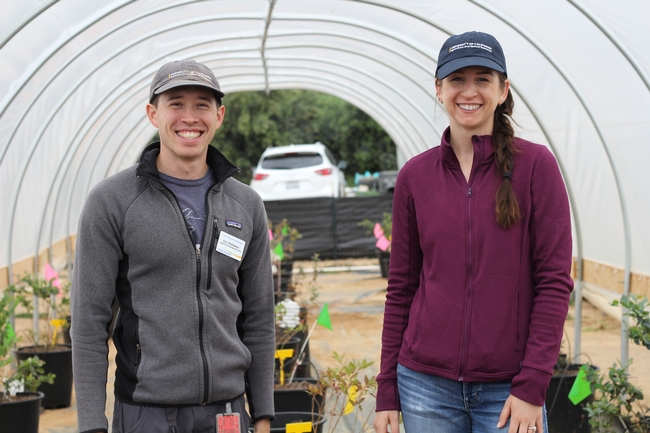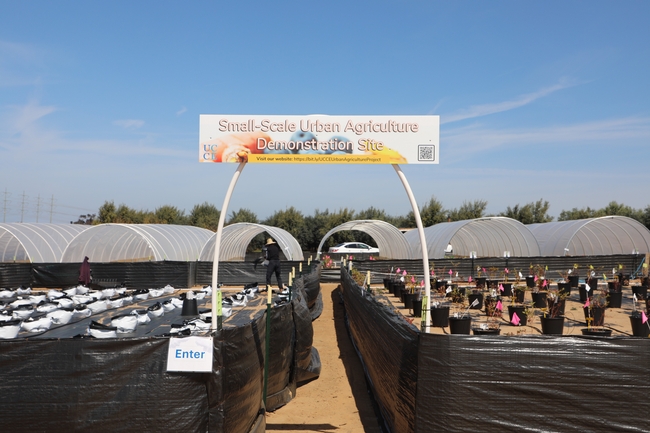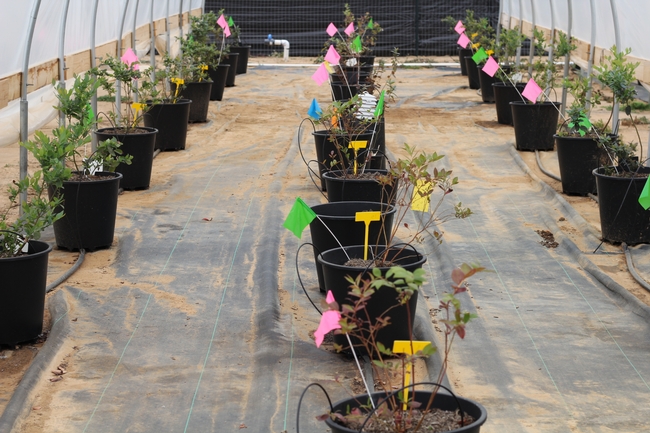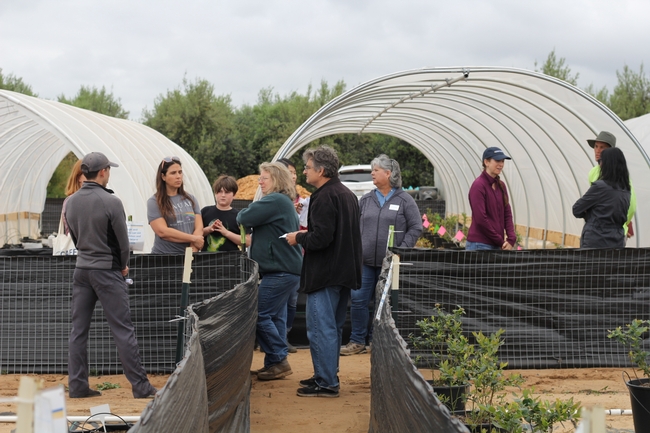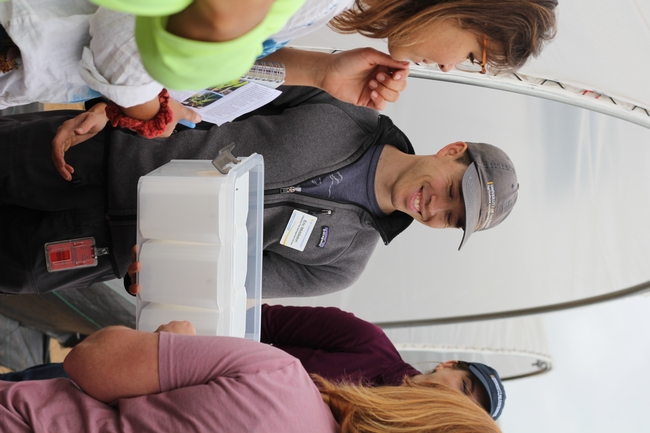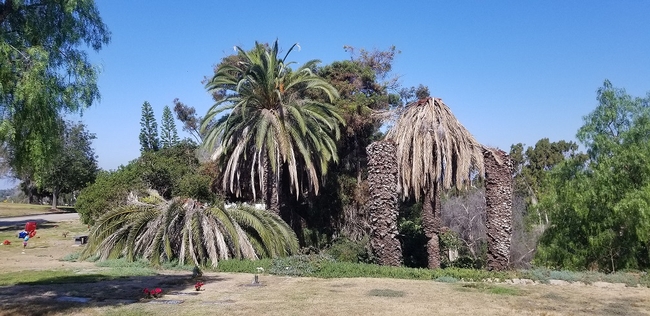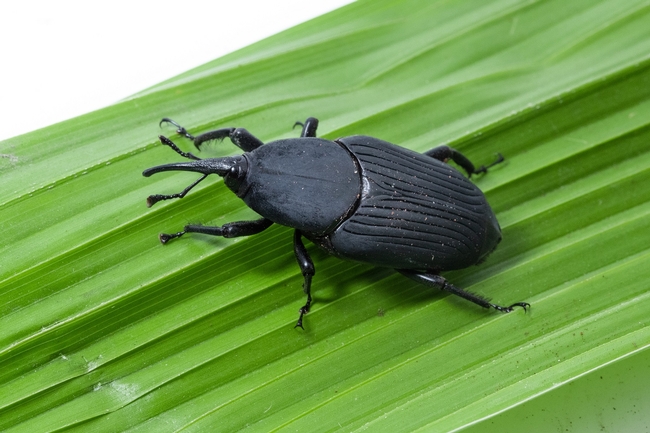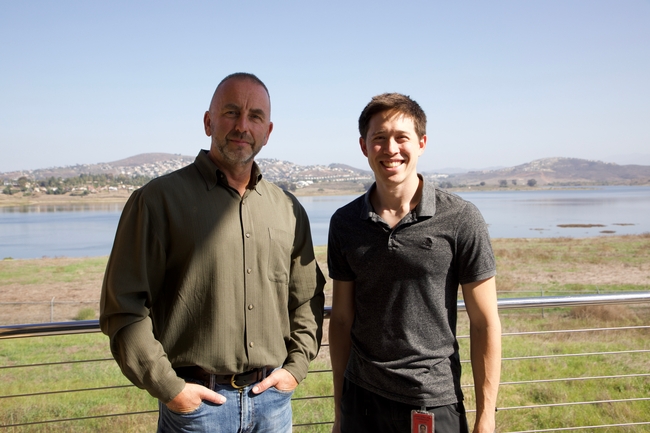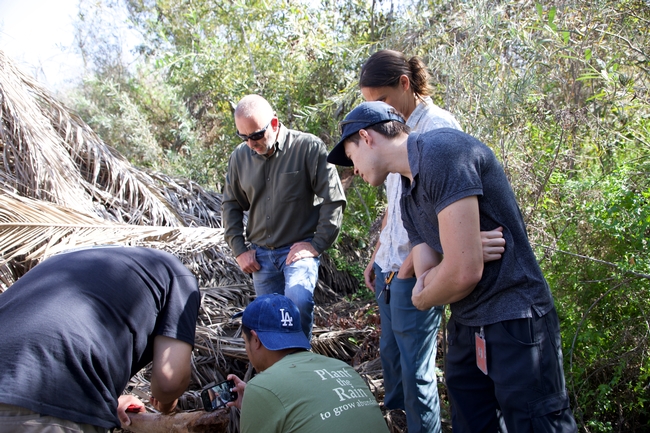Posts Tagged: Middleton
Could empty lots be growing food, economic opportunity?
UCCE scientists study feasibility of specialty crops for small urban growers
The vacant lots around your neighborhood could be growing fruits and vegetables and making local produce more accessible – while reducing energy needed to transport and distribute the food. Could turning those empty lots into small farms also become opportunities for economic development?
To answer this question, a team of researchers from University of California Cooperative Extension in San Diego County are investigating the economic feasibility of growing high-value specialty crops in urban settings like vacant lots. The project – led by Eric Middleton, UCCE integrated pest management advisor for San Diego, Orange and Los Angeles counties – is currently in progress at The Flower Fields in Carlsbad, a seasonal attraction for locals and tourists.
Tucked away in the back of the field is the Small-Scale Urban Ag Demonstration Site where Middleton and his team established a small farm on approximately 17,000 square feet, starting fall 2023. Funded by the U.S. Department of Agriculture National Institute of Food and Agriculture, the farm is designed to evaluate containerized production both outdoors and under high tunnels.
Growers don't necessarily need land, just space
High tunnels, also referred to as hoop houses, are semi-permanent structures that act similarly to greenhouses in providing a controlled environment. For the experiment, Middleton will compare cost, effort and durability of two types of high tunnels: one made of steel and the other out of PVC pipes.
“We want to give interested growers information on as many options as we can,” said Middleton, who explained that the project is motivated by the challenges of urban settings, including limited space and lack of arable land.
In the trial, they are growing turmeric, ginger and blueberries. The high-value crops were selected because of their potential to earn a profit. Data evaluating plant variety, soil mix, fertilizer, growth performance, yield and pest and disease pressures will be collected and reported when the project concludes in 2026.
As the crops develop in containers – blueberries in pots and turmeric and ginger in grow bags – Middleton pointed out the mobility aspect of the study, noting that growers don't necessarily need land, just space.
Whether it's a backyard or a rooftop, containerized production means easier transport, especially since vacant land doesn't always remain vacant forever and urban lots may often need soil remediation. Growing in containers solves the anticipated problem of having to relocate.
Where to set up shop in San Diego County
Jan Gonzales, project coordinator and community education supervisor for UCCE San Diego County, is leading the effort to identify available urban land in San Diego County as well as the policies and procedures for growers to access these spaces.
Gonzales is collaborating with community members who are working on similar projects to identify space for prospective growers.
“This has been done before for different objectives and for specific areas in the region, but the information was either project-specific and not publicly available, or not easy to find,” Gonzales said.
Having spoken with people associated with previous or ongoing agricultural land mapping projects, Gonzales has agreed to coordinate and facilitate an advisory work group to discuss areas of potential collaboration and develop project efficiencies. She anticipates holding the first group meeting before the end of the summer.
A production guide to help community members re-create the project
The ideal audience for a study like this is anyone who wants to grow specialty crops, according to Lindsey Pedroncelli, interim director of UC South Coast Research and Extension Center in Irvine, who worked on the project alongside Middleton when she was a staff research associate with UCCE San Diego.
“If you're a new grower or a grower who wants to diversify your crop production, what we're learning here can be applied to you,” said Pedroncelli.
Pedroncelli has been instrumental in bringing the experiment to life and documenting its step-by-step workflow thus far. The production guide, which is being created as the study unfolds, will include instructions detailing how to replicate the experiment from the ground up. Currently, it contains information on how to design your farm, the materials to buy, building structures, irrigation setup and crop management.
The most intriguing open question, whether the operation is profitable, is the driving force behind the production guide and will certainly be addressed, Pedroncelli said.
Book a tour and visit the farm
When visiting the farm, you'll encounter three varieties of blueberries: Star, Snowchaser and Misty. Snowchaser has been a top producer since it was planted in January, but the variety is known to be an early season producer.
Using only one variety of each, the turmeric and ginger were planted in late March-early April. With some unanticipated cold weather in San Diego County, both crops struggled when transitioning out of dormancy, leading to very slow progress, which the team is still navigating today.
Visually, Middleton and his team have noticed differences between the crops growing under the high tunnels versus those grown outdoors, although the data has not been analyzed to confirm or explain notable differences.
Attempting to demonstrate how to profitably grow high-value crops in urban settings using limited space and resources, Pedroncelli said she hopes this study will also encourage people to grow culturally significant crops for their communities.
To tour the Small-Scale Urban Ag Demonstration Site at The Flower Fields in Carlsbad, email Eric Middleton at egmiddleton@ucanr.edu with "Urban Agriculture Demonstration Site Tour" in the subject line.
To learn more about the project and its progress, visit https://ucanr.edu/sites/socalIPM/Small_Scale_Urban_Agriculture_Project_/.
Lawn-pocalypse! Surviving Drought
Ah, summer! The season of sunburns, pool parties, and… lawn droughts. If your once lush, green carpet now looks like a crunchy brown doormat, you're not alone. Let's dive into why your yard is staging a dramatic death scene and what you can do to...

Bermuda grass and weeds overtaking drought stressed turf grass.
Bruce Hammock Inducted as Fellow of the California Academy of Sciences
UC Davis distinguished professor Bruce Hammock, internationally recognized for discovering a new group of human chemical mediators, is a newly inducted Fellow of the California Academy of Sciences (CAS). Hammock, who holds a joint appointment...

UC Davis distinguished professor Bruce Hammock in his office in Briggs Hall. (Photo by Kathy Keatley Garvey)

The California Academy of Sciences building. (2008 Copyrighted Photo by Tim Griffith, California Academy of Sciences)
Palm weevil threatens So Cal palm trees
More than 20,000 palms in the region have been killed by South American palm weevil
The swaying palm trees that line San Diego's streets might not be swaying much longer due to a pest that is infecting many of these iconic trees and making its way across Southern California.
The South American palm weevil (SAPW), also referred to as the American palm weevil and black palm weevil, was first detected in San Diego County in 2011, with breeding populations found in a Canary Island date palm in San Ysidro in 2015. According to industry experts, more than 20,000 palms in the region have been killed by SAPW thus far.
While SAPW can attack a variety of palm tree species, Canary Island date palms (Phoenix canariensis) are by far their most preferred host. SAPW adults lay their eggs in the crown of palm trees and then larvae hatch and voraciously consume the growing tissue of the palm. If left unchecked, this pest can kill mature palms in a matter of months.
SAPW has affected neighborhoods and cities throughout the greater San Diego area, creating a need for more residents to be aware of this concern and report infected palms. Though infestation has not been confirmed, SAPW adults have been reported in the Coachella Valley – about 120 miles northeast of San Diego.
‘Super-dispersers' from San Diego can fly long distances
The California Department of Food and Agriculture has trapped weevils in the Coachella Valley and recent posts on iNaturalist, a social network for community members to map and share observations of biodiversity across the globe, indicate that adult weevils are flying into areas where edible dates are grown.
These reports interest researchers like Mark Hoddle, University of California Cooperative Extension based at UC Riverside, because the Coachella Valley, the major production area for edible dates nationwide, is far from any known infested palm trees.
How did the weevils get there? “It may be super-dispersers from San Diego,” said Hoddle. “They are on a death mission when they fly long distances – find food or die trying!”
While conducting an experiment to assess SAPW's flight capability, Hoddle and his team learned that the beetle could fly non-stop for up to five hours, with some variation between males and females. “In some cases, they will fly until they die,” Hoddle said.
Currently, Hoddle is managing an ongoing urban palm surveillance effort of 521 palm trees in and around Bonita in San Diego County, which are assessed every six months. More than 70% of these palms have been killed by SAPW over a 6.5-year period.
Although Canary Island date palms are highly preferred by SAPW, the weevils can complete their entire life cycle in sugarcane as well. For palm species that are not currently preferred by the pest, there is still a chance that they can become more preferred over time as SAPW works its way through all available Canary Island date palms in the region.
Taking action to protect your palms
There are steps that one can take to protect palm trees. Traps can be used to both monitor weevils and reduce the number of adults flying around. There are two types of traps that Hoddle has evaluated for weevil captures: the bucket trap and the Picusan trap. Both use a fermenting bait – prepared with dates, baker's yeast and water – that is placed in a glass jar with a perforated lid, in addition to a commercially available aggregation pheromone that will attract male and female weevils.
Of the two trap types, Hoddle prefers Picusan traps because they catch about six times as many weevils as bucket traps – retaining more than 95% of the weevils that are attracted to them. Bucket traps, on the other hand, retain only about 30% of weevils.
Hoddle emphasizes that trap placement is key. The Picusan trap is designed to be placed on the ground, whereas the bucket trap is typically hung from a tree branch, fence or post. Furthermore, the traps should be placed at least 500 yards away from the potential host palms and avoid direct sunlight. Shaded or partially shaded areas are best to avoid diminishing the trap's potency.
Another strategy is to prune palm trees when SAPW flight activity is low (December through March) to minimize attracting flying adult weevils to freshly pruned palms.
Finally, the best way to protect your tree is to apply insecticides. These chemicals will kill adult weevils that attempt to start infestations. While contact insecticides can deter and kill adults when applied to the crown of the palm, systemic insecticides are usually more effective and can be applied as soil and crown drenches, trunk sprays, or soil and trunk injections. Systemic insecticides move inside the palm and concentrate in the palm heart, the growing area at the top of the palm where weevils feed. Once this growing area is damaged by feeding weevil larvae, palms die.
“Just know that if you are planning to protect palms with insecticides, you are in it for life,” saidHoddle, emphasizing that there is no “one and done” approach to saving palms affected bySAPW. “Don't start if you can't commit.
Aesthetics aren't the only motivation to prevent palm infection and death caused by SAPW. Palm crowns that are highly damaged by larval feeding can detach from the top of the trunk and fall to the ground, putting people and property at risk. Dead fronds drop from dying palms and the large spines at the base of the fronds are a significant hazard to people and pets.
Seek expert support for tree concerns and removal
Removing dead palms is an expensive and time-consuming process. Removal can cost between $2,400 to $4,000 per palm, with cost varying based on location. For example, if a palm is in an area that requires the use of a crane, semitruck or helicopter to safely access, remove and dispose of the dead palm, tree removal can cost up to $15,000.
Once a palm is infested with SAPW, it likely cannot be saved unless it is aggressively treated with insecticides at an early stage of the infestation. If you are certain that a tree is infected by SAPW, it is highly recommended that you work with a tree care company or arborist to manage the weevils that might be present in the palm and to promptly and responsibly dispose of dead palms so that spread of weevils into new areas is minimized.
To confirm visual signs of palm trees that have been affected by SAPW, visit Hoddle's site for more information and to report infested palms: https://cisr.ucr.edu/invasive-species/palmarum-survey.
To read this story in Spanish, visit: https://ucanr.edu/blogs/blogcore/postdetail.cfm?postnum=58381
Climate-Change Resources
University of California UC ANR Green Blog (Climate Change and Other Topics) https://ucanr.edu/blogs/Green/index.cfm?tagname=climate%20change (full index)
Examples:
- Save Trees First: Tips to Keep Them Alive Under Drought https://ucanr.edu/b/~CdD
- Landscaping with Fire Exposure in Mind: https://ucanr.edu/b/~G4D
- Cities in California Inland Areas Must Make Street Tree Changes to adapt to Future Climate https://ucanr.edu/b/~oF7
Drought, Climate Change and California Water Management Ted Grantham, UC Cooperative Extension specialist (23 minutes) https://youtu.be/dlimj75Wn9Q
Climate Variability and Change: Trends and Impacts on CA Agriculture Tapan Pathak, UC Cooperative Extension specialist (24 minutes) https://youtu.be/bIHI0yqqQJc
California Institute for Water Resources (links to blogs, talks, podcasts, water experts, etc.) https://ciwr.ucanr.edu/California_Drought_Expertise/
UC ANR Wildfire Resources (publications, videos, etc.) https://ucanr.edu/News/For_the_media/Press_kits/Wildfire/ (main website)
-UC ANR Fire Resources and Information https://ucanr.edu/sites/fire/ (main website)
-Preparing Home Landscaping https://ucanr.edu/sites/fire/Prepare/Landscaping/
UC ANR Free Publications https://anrcatalog.ucanr.edu/ (main website)
- Benefits of Plants to Humans and Urban Ecosystems: https://anrcatalog.ucanr.edu/pdf/8726.pdf
-Keeping Plants Alive Under Drought and Water Restrictions (English version) https://anrcatalog.ucanr.edu/pdf/8553.pdf
(Spanish version) https://anrcatalog.ucanr.edu/pdf/8628.pdf
- Use of Graywater in Urban Landscapes https://anrcatalog.ucanr.edu/pdf/8536.pdf
- Sustainable Landscaping in California https://anrcatalog.ucanr.edu/pdf/8504.pdf
Other (Non-UC) Climate Change Resources
Urban Forests and Climate Change. Urban forests play an important role in climate change mitigation and adaptation. Active stewardship of a community's forestry assets can strengthen local resilience to climate change while creating more sustainable and desirable places to live. https://www.fs.usda.gov/ccrc/topics/urban-forests
Examining the Viability of Planting Trees to Mitigate Climate Change (plausible at the forest level) https://climate.nasa.gov/news/2927/examining-the-viability-of-planting-trees-to-help-mitigate-climate-change/
Reports and other information resources coordinated under the auspices of the United Nations and produced through the collaboration of thousands of international scientists to provide a clear and up to date view of the current state of scientific knowledge relevant to climate change. United Nations Climate Action
Scientific reports, programs, action movements and events related to climate change. National Center for Atmospheric Research (National Science Foundation)
Find useful reports, program information and other documents resulting from federally funded research and development into the behavior of the atmosphere and related physical, biological and social systems. Search and find climate data from prehistory through to an hour ago in the world's largest climate data archive. (Formerly the "Climatic Data Center") National Centers for Environmental Information (NOAA)
Think tank providing information, analysis, policy and solution development for addressing climate change and energy issues (formerly known as the: "Pew Center on Global Climate Change"). Center for Climate & Energy Solutions (C2ES)
Mapping Resilience: A Blueprint for Thriving in the Face of Climate Disaster. The Climate Adaptation Knowledge Exchange (CAKE) was launched in July 2010 and is managed by EcoAdapt, a non-profit with a singular mission: to create a robust future in the face of climate change by bringing together diverse players to reshape planning and management in response to rapid climate change. https://www.cakex.org/documents/mapping-resilience-blueprint-thriving-face-climate-disaster
Cal-Adapt provides a way to explore peer-reviewed data that portrays how climate change might affect California at the state and local level. We make this data available through downloads, visualizations, and the Cal-Adapt API for your research, outreach, and adaptation planning needs. Cal-Adapt is a collaboration between state agency funding programs, university and private sector researchers https://cal-adapt.org/
Find reports, maps, data and other resources produced through a confederation of the research arms of 13 Federal departments and agencies that carry out research and develop and maintain capabilities that support the Nation's response to global change. Global Change (U.S. Global Change Research Program)
The Pacific Institute is a global water think tank that combines science-based thought leadership with active outreach to influence local, national, and international efforts to develop sustainable water policies. https://pacinst.org/our-approach/
Making equity real in climate adaptation and community resilience policies and programs: a guidebook. https://greenlining.org/publications/2019/making-equity-real-in-climate-adaption-and-community-resilience-policies-and-programs-a-guidebook/
Quarterly CA Climate Updates and CA Drought Monitor Maps (updated each Thursday) https://www.drought.gov/documents/quarterly-climate-impacts-and-outlook-western-region-june-2022

